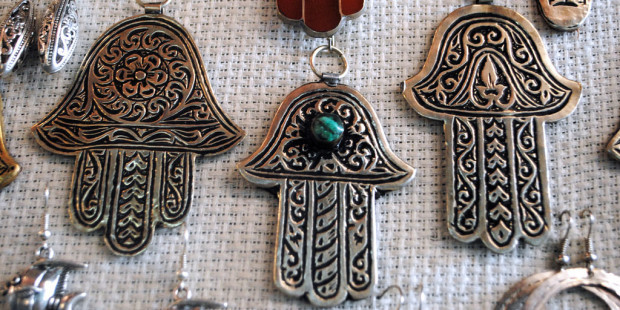Judaism: the hamsa hand and what it represents
The hamsa, or hand of hamsa, is a talisman of the ancient Middle East. In its most common form, the amulet is shaped like a hand with three fingers extended in the middle and a curved thumb or little finger on both sides. It is thought to protect against the "evil eye". It is often displayed on necklaces or bracelets, although it can also be found in other decorative elements such as tapestries.
Hamsa is often associated with Judaism, but it is also found in some branches of Islam, Hinduism, Christianity, Buddhism and other traditions and, more recently, it has been adopted by modern New Age spirituality.
Meaning and origins
The word hamsa (חַמְסָה) derives from the Hebrew word hamesh, which means five. Hamsa refers to the fact that there are five fingers on the talisman, although some also believe that it represents the five books of the Torah (Genesis, Exodus, Leviticus, Numbers, Deuteronomy). Sometimes it is called the hand of Miriam, who was the sister of Moses.
In Islam, hamsa is called the Hand of Fatima, in honor of one of the daughters of the prophet Muhammad. Some say that, in the Islamic tradition, the five fingers represent the five pillars of Islam. In fact, one of the first most powerful examples of the hamsa in use appears on the Judgment Gate (Puerta Judiciaria) of the XNUMXth century Spanish Islamic fortress, the Alhambra.
Many scholars believe that hamsa is antecedent to Judaism and Islam, possibly with totally non-religious origins, although in the end there are no certainties about its origins. Regardless, the Talmud accepts amulets (kamiyot, from the Hebrew "to tie") as commonplace, with Shabbat 53a and 61a approving the transport of an amulet to Shabbat.
Symbolism of the Hamsa
The hamsa always has three extended middle fingers, but there are some variations in the display of the thumb and little finger. Sometimes they are curved outwards and other times they are significantly shorter than the middle. Whatever their shape, the thumb and little finger are always symmetrical.
In addition to being modeled as an oddly shaped hand, hamsa will often have an eye in the palm of your hand. The eye is believed to be a powerful talisman against the "evil eye" or ayin hara (עין הרע).
Ayin hara is believed to be the cause of all the world's suffering and although its modern use is difficult to trace, the term is found in the Torah: Sarah gives Hagar an ayin hara in Genesis 16: 5, which causes a miscarriage, and in Genesis 42: 5, Jacob warns his children that they are not being seen together because it may arouse ayin hara.
Other symbols that may appear on hamsa include fish and Hebrew words. Fish are thought to be immune to the evil eye and are also symbols of good luck. Next to the theme of luck, mazal or mazel (which means "luck" in Hebrew) is a word that is sometimes written on the amulet.
In modern times, hams are often present on jewelry, hung at home or as a larger design in Judaica. Be that as it may, the amulet is thought to bring luck and happiness.
